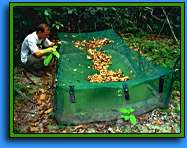| C l a u d e G a s c o n
 I initially came down about 10 years ago in 1987 to start some field work
for my Ph.D., working primarily with frogs and tadpoles, trying to
understand where frogs breed, looking at what aquatic or terrestrial habitat
frogs need to be able to breed successfully and to establish healthy
populations in natural forests. That type of basic natural history
information is extremely important for us to understand the natural
situation, and then to be able to compare that with any modified situation,
such as cutting down large areas of forests and what happens
to the frogs. If their breeding requirements or their feeding requirements
are not met in this modified landscape, then we can expect and predict that
they will be negatively affected.
I initially came down about 10 years ago in 1987 to start some field work
for my Ph.D., working primarily with frogs and tadpoles, trying to
understand where frogs breed, looking at what aquatic or terrestrial habitat
frogs need to be able to breed successfully and to establish healthy
populations in natural forests. That type of basic natural history
information is extremely important for us to understand the natural
situation, and then to be able to compare that with any modified situation,
such as cutting down large areas of forests and what happens
to the frogs. If their breeding requirements or their feeding requirements
are not met in this modified landscape, then we can expect and predict that
they will be negatively affected.
(Claude got started on his career through an exercise in research and
imagination directly paralleling one suggested for students in the LFRF
Teacher’s Guide.)
 There was one biology teacher in university in my first ecology course who
asked us to do a paper that essentially asked us to become any animal or any
plant that we decided to choose and describe in a written essay how we, as
that animal or plant, would live, what we needed to survive, where we lived
and under what conditions, etc. And after a couple of days of thinking, I
chose to be a frog and put myself in the skin of a frog and started to look
in books and do some
research. I wrote a paper that got me really interested in frogs, and that
led to more interest, and the more I read the more I got interested, and I
eventually had a chance to start some graduate work with frogs in Canada,
and then had a great opportunity to come here and continue my research with
frogs.
There was one biology teacher in university in my first ecology course who
asked us to do a paper that essentially asked us to become any animal or any
plant that we decided to choose and describe in a written essay how we, as
that animal or plant, would live, what we needed to survive, where we lived
and under what conditions, etc. And after a couple of days of thinking, I
chose to be a frog and put myself in the skin of a frog and started to look
in books and do some
research. I wrote a paper that got me really interested in frogs, and that
led to more interest, and the more I read the more I got interested, and I
eventually had a chance to start some graduate work with frogs in Canada,
and then had a great opportunity to come here and continue my research with
frogs.
|
![]()
![]()